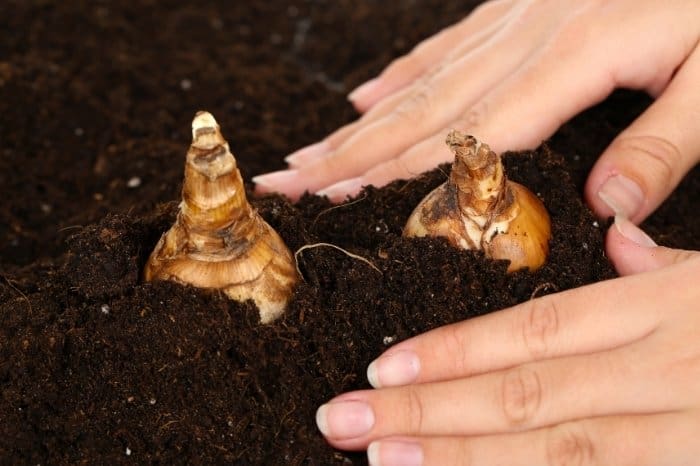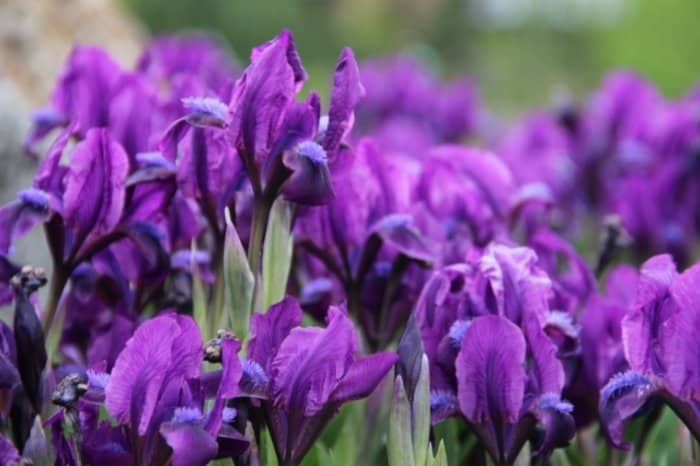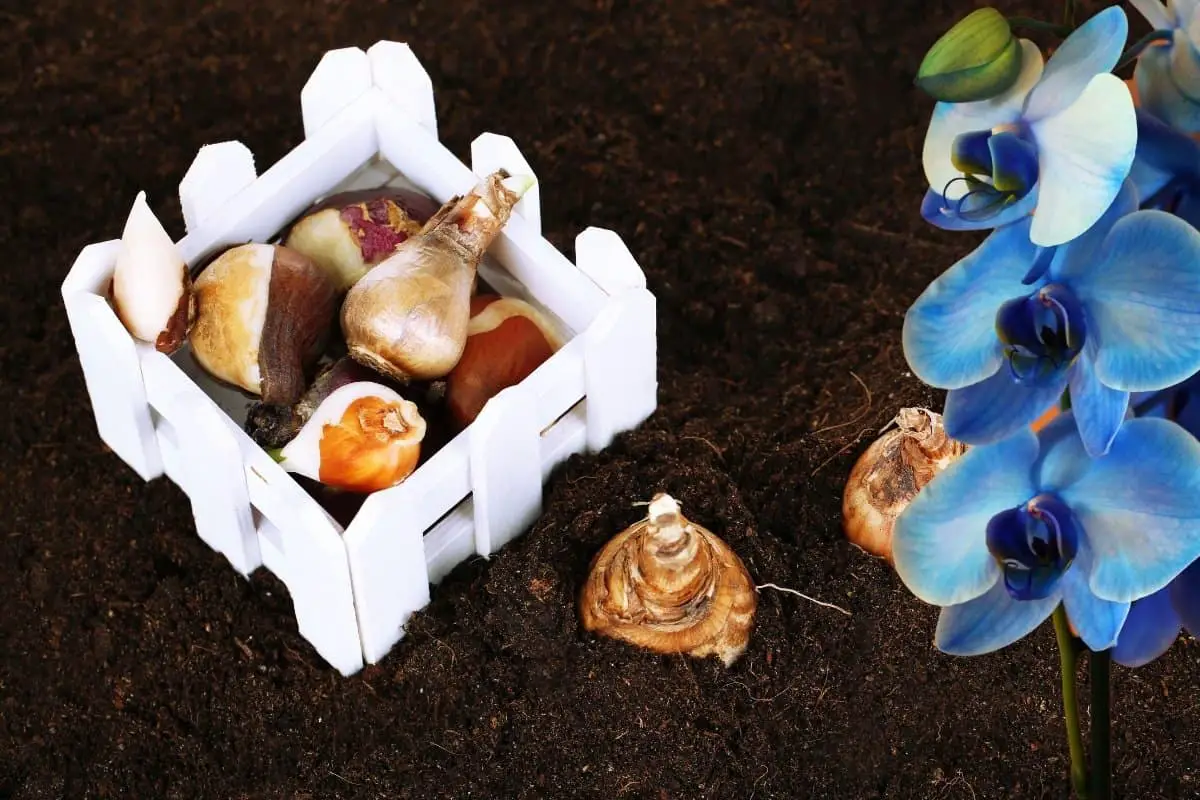Last Updated on February 10, 2022 by
You may wonder how deep do you plant iris bulbs for the best display; in this article, we will look at all that and more.
Iris bulbs are popularly called the goddess of the rainbow because they fill the garden with colourful blooms in spring and early summer.
Iris reticulata and Iris histrioides are two types that are popular among gardeners who grow irises. These flowers are a joy to see on the doorstep to cheer you up every morning and remind you summer is around the corner.
You can also grow the spring- and summer-flowering Dutch irises – Iris hollandica and Siberian irises Iris sibirica, that flower in May and June. The bearded irises – Iris germanica and the Japanese water iris – Iris ensata, whose flowers can go into July.
All these irises are diverse in colour and size and here are some common varieties:
- The tall varieties that are instrumental in providing drifts of colour in spring
- The deeply glamorous types in unusual coppery shades or sugar-almond-pink
- The delicate, miniature irises, which do so well in pots and are so pretty.
How Deep Do You Plant Iris Bulbs?
The most favourite type, Dutch Iris bulbs bloom in spring in gorgeous shades of lilac, bronze, royal blue, red and yellow.
If you have been wondering how deep you plant iris bulbs, plant them in the same way as tulips. Choose a sunny site with well-drained soil for the best display and plant the bulbs from September to December before frost begins.

Plant the bulbs in holes of 4-inches deep and 2 to 4-inches apart. For larger groups, make a trench, position the bulbs, then put back the soil and water them well.
Growing Irises
Growing Irises is fun and easy to manage. Let’s look at the right way to grow them.
- Soil Type: Rich, well-drained, fertile soil is best for irises. If the soil is heavy growth, these flowers may be unsuccessful. If you have heavy soil, adding grit to the planting hole is a good idea to make your soil well-drained.
- Sunlight: Full sun is ideal for most irises, although some varieties do well in part shade – Iris reticulata and Iris histrioides. The taller types do well in a sheltered position and work well to minimize wind damage.
- Irises Bulb Planting: The best time to plant irises bulbs is in September and October, but they can be planted in November. Bearded iris rhizomes are best planted in August-October. Beardless potted irises can be planted starting spring to autumn.
- How To Plant Iris Bulbs:Plant your iris bulbs on well-drained soils that have enough moisture. Bearded irises should be planted at least 1 ft. apart, with the upper part of the rhizome partially exposed so it can get a late summer baking. Avoid overcrowding your iris plants as this shades the rhizomes, leading them to give fewer flowers. Bare root rhizomes should be soaked briefly before planting. These two varieties – Iris reticulata and Iris histrioides bulbs can be planted much more closely at 4 inches apart and 3 inches deep.
Reblooming Bearded Iris Bernice’s Legacy- Rare Red – 1 Large Rhizome
Caring For Irises
Mulching
Add mulch each spring, avoiding contact with the rhizomes as it leads to the bulbs rot. Remove all drying foliage in the autumn to prepare the plant for new shoots after winter.
Watering
Irises love water, but they hate to be waterlogged. Ensure your soil drains well and won’t hold water for too long, especially when growing these flowers in a pot. Water your newly planted bulbs and rhizomes at least once every week unless it’s raining. During a prolonged dry period, water your irises paying close attention to pots and newly planted bulbs and rhizomes.
Fertilizing
You can add a layer of old manure, compost, or other mulch around the rhizomes and bulbs in early spring to fertilise your soil. Avoid contact with exposed rhizomes to reduce the risk of root rot.
Deadheading
You can cut old flowers after flowering to allow more flowers to bloom. Cut them off where the flower meets the foliage. For bulbs, leave the foliage in place; only remove it once it has fully died back to allow the leaves to go through photosynthesis undisturbed. This will give the plant energy in the coming year.
Propagating And Dividing
Some irises, like bearded irises, can be propagated by division. When you notice the clumps have become congested, divide them every 3 to 5 years. You can do this every 6 weeks after flowering to give the plant a chance to establish itself before winter.
When dividing, remember that rhizomes grow outwards, so discard the centre of the plant to remove the oldest parts and plant the outer rhizomes in an improved ground.
Lifting And Storing
Irises can be left in borders or grass clamps to grow year after year. However, if you grow yours in a pot, you will need to lift and store them to plant in the following autumn.
Lift your bulbs after the foliage has completely died back. Shake off the soil and leave them to dry before placing them in a netted bag. Hang them in a cool and dry place like a cellar or a shed.

FAQs
What month do you plant iris bulbs?
Iris are planted in the spring and flower from late May to early September. If you're going to plant in March or April, make sure that the soil is warm enough for them. How do I know which type of iris bulb to buy? There are three types of iris bulbs: 'fairy','sparkler' and 'disco'.
Each has different qualities. The fairy iris is most often used as a cut flower. It's a very fragrant flower with long stems, which can grow up to 12 inches tall. The sparkler iris is more compact and usually grows to only 6 inches tall. Disco iris bulbs have the longest stems of all the types.
Iris bulbs should be planted directly into the ground, but you can also plant them in containers, as long as the pot is at least 10 inches deep. Be sure to keep the soil moist until they begin to grow, and then water sparingly until the flowers appear. If you want to plant them in the spring, you can put the bulbs in the ground after the last frost.
How deep do iris bulbs need to be planted?
Iris bulbs should be planted at least 1 inch deep. When you plant the bulb, you want to have the top of the bulb buried a bit so that you can water it well without damaging the bulb. The soil around the bulb should be moist but not soggy. The bulbs will need to grow roots before they bloom.
You can either plant the bulbs directly in the ground or plant them in individual pots. The best time to plant your bulbs is from March to May. In colder climates, you can also plant them in early fall and then bring them inside over the winter.
How long do iris bulbs take to grow?
Iris bulbs take from 4 to 5 years to fully bloom and bloom for 3-4 weeks. It will be an exciting time for you and your guests when they see the irises for the first time! Iris bulbs are a perennial in zones 7-9 and can be divided every two or three years. You can plant in spring or fall depending on your climate.
Irises prefer to grow in full sun. They require ample water and fertile soil to thrive.
Can you plant iris bulbs in pots?
The only thing that really matters is the size of the pot. The bigger the pot the more time it will take to get established.
Iris is one of the most popular flowering plants for a very good reason. The flowers are so beautiful and vibrant, they really stand out from the crowd. They are also easy to grow, once you have the right growing conditions. Iris bulbs are best planted in the springtime, but can be planted as late as fall. You may be able to find them at a local garden center. They should be stored in a cool and dry place until they are ready to be planted.
Conclusion
FAQs
What month do you plant iris bulbs?
Iris are planted in the spring and flower from late May to early September. If you're going to plant in March or April, make sure that the soil is warm enough for them. How do I know which type of iris bulb to buy? There are three types of iris bulbs: 'fairy','sparkler' and 'disco'.
Each has different qualities. The fairy iris is most often used as a cut flower. It's a very fragrant flower with long stems, which can grow up to 12 inches tall. The sparkler iris is more compact and usually grows to only 6 inches tall. Disco iris bulbs have the longest stems of all the types.
Iris bulbs should be planted directly into the ground, but you can also plant them in containers, as long as the pot is at least 10 inches deep. Be sure to keep the soil moist until they begin to grow, and then water sparingly until the flowers appear. If you want to plant them in the spring, you can put the bulbs in the ground after the last frost.
How deep do iris bulbs need to be planted?
Iris bulbs should be planted at least 1 inch deep. When you plant the bulb, you want to have the top of the bulb buried a bit so that you can water it well without damaging the bulb. The soil around the bulb should be moist but not soggy. The bulbs will need to grow roots before they bloom.
You can either plant the bulbs directly in the ground or plant them in individual pots. The best time to plant your bulbs is from March to May. In colder climates, you can also plant them in early fall and then bring them inside over the winter.
How long do iris bulbs take to grow?
Iris bulbs take from 4 to 5 years to fully bloom and bloom for 3-4 weeks. It will be an exciting time for you and your guests when they see the irises for the first time! Iris bulbs are a perennial in zones 7-9 and can be divided every two or three years. You can plant in spring or fall depending on your climate.
Irises prefer to grow in full sun. They require ample water and fertile soil to thrive.
Can you plant iris bulbs in pots?
The only thing that really matters is the size of the pot. The bigger the pot the more time it will take to get established.
Iris is one of the most popular flowering plants for a very good reason. The flowers are so beautiful and vibrant, they really stand out from the crowd. They are also easy to grow, once you have the right growing conditions. Iris bulbs are best planted in the springtime, but can be planted as late as fall. You may be able to find them at a local garden center. They should be stored in a cool and dry place until they are ready to be planted.
It is critical to plant your iris bulbs as soon as you receive them in the post. If not immediately, plant them as soon as possible to avoid destroying them. For optimum growth, find a sunny spot where the soil is well-drained.
Irises are low maintenance flowers, so caring for them will be easy even for a busy gardener. Just ensure your soil is draining properly and they are under full sunlight.
Remember to plant them in the right depth for each type to avoid exposure to tough weather elements. Now that you know how to grow irises and the minimal care it needs, why don’t you go on and try growing your own?
It may look tough, but gardening is therapeutic and has a way of healing emotional stress. Try it today and see! You will never again abandon it. Happy gardening, friends! You can do this and more!
Caroline is a gardener who loves to get down to the nitty–gritty of gardening. She proudly proclaims herself as a ‘dirt worshipper‘ and can often be found deep in the garden, covered in soil and singing to her plants. As a self–proclaimed ‘plant whisperer‘, Caroline believes that plants need love and attention just like any other living thing, and she loves to give them both. When she‘s not tending to her garden, you can often find her researching the latest gardening trends, or teaching others how to make their gardens thrive



